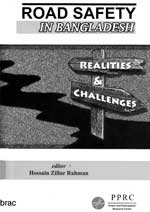
Outlining road safety in Bangladesh
Helal Uddin Ahmed | Friday, 21 November 2014

As the editor of this research book says, "Road accidents are the new epidemic sweeping across much of the developing world". With its rapid urbanisation and exponential growth of transport networks, safety on the roads has emerged as an inescapable priority for Bangladesh. Against this backdrop, Bangladesh Rural Advancement Committee (BRAC) has commissioned the PPRC research team to undertake a causal study on road safety in order to devise an appropriate advocacy strategy on this vital national issue.
The outcome has been this remarkable book of 130 pages, comprising numerous tables, charts and graphs, and touching on the relevant themes like why road safety has now become a major concern, the magnitude and trends of road accidents in Bangladesh, the victims and perpetrators of mishaps, post-accident investigation and medical facilities, survey of drivers, causes of road accidents, relevant laws and institutions, improving road safety; and recommendations for improving the situation.
The most important segment of this research volume is its tenth chapter, where key findings of the study have been summarised alongside a recommendations-matrix covering diverse areas like governance in road safety, engineering safety, vehicle management, road users; accidents and post-accident issues, and advocacy challenges.
A key finding of the BRAC-PPRC study has been that, road accidents are occurring not on all the highways and streets, but at some 'black spots' that see repetitive accidents. The total length of accident-prone highways has been found to be around 57 kilometres.
The road safety division of Roads and Highways Department has identified 209 such 'black spots'. However, this list should be updated regularly as the number of rural roads coping with sharply increasing road traffic is constantly on the rise.
Another key finding of the study is that accidents occur frequently not on isolated road stretches, but at crowded intersections and bus stands, which are poorly planned or poorly regulated. Road curves with poor visibility are also responsible for a large share of the accidents.
Seventy-six per cent accident victims come from the vulnerable road users. The groups at maximum risks are pedestrians (41 per cent); passengers of light vehicles (19 per cent); motor-cyclists/three-wheeler passengers (16 per cent).
The 'hit and run' category accounts for 42 per cent of the accidents; 19 per cent are head-on collisions, and 13 per cent accidents occur due to overturning of vehicles.
Another key finding of the study is that a holistic safety agenda is needed as there are multiple causes of road accidents. These causes include reckless driving, untrained drivers, unfit vehicles, simultaneous (side-by-side) movement of motorised and non-motorised vehicles without any separation or segregation rules, risky roadside activities, faulty road-designs, poor traffic rule enforcement, dearth of road safety awareness, and a culture of impunity characterised by poor legal redress.
There also exist significant gaps and loopholes in laws and policies. The laws and policies have not been updated on a regular basis, and the principal legal instrument - Motor Vehicle Ordinance 1983 - is essentially a colonial legacy which is grossly out-of-date.
Political and economic factors have also been found to be major impediments to the road safety agenda. Entrenched power nexuses prevent actions against unfit vehicles, facilitate issuance of irrational route permits, encourage encroachments on or occupations of roadside public lands, and lead to inappropriate penalties for the perpetrators of road accidents.
Dominance of influential political leaders is observed in the ownership of many transport entities as well as the control of transport workers' unions, and the problems are further compounded by the complicity or inaction on the part of the quarters concerned.
The ten priority recommendations made by the study are as follows: holding of a national dialogue for early passage of an appropriately updated road traffic law; regular updating of the accident 'black-spot' list, priority engineering action plan on the black-spots' improvement along with targeted awareness initiatives; improved road engineering solutions with priority to geometric standard, intersection design, access control on highways, pedestrian facilities, parking spots, regular maintenance and adoption of road safety audit approach; undertaking a comprehensive study on optimal resolution of road-building and roadside economic activities; introduction of independent economic code for road safety projects in the budgetary process; promotion of quality driving schools; scaling up a national road safety awareness programme by targeting the drivers and vulnerable road users; establishment of a National Traffic Training Academy along with a comprehensive review of current approaches to traffic planning and management by the police; promotion of community traffic-policing solutions to prevent irrational traffic congestions and ensure safe use of roads; improving accident-related trauma-reducing facilities with focus on emergency critical care, alongside introduction of an emergency access contact number and availability of affordable assistive devices.
The PPRC (Power and Participation Research Centre) was established in 1996 as an independent think tank focused on issues of poverty, growth, governance, education, urban transition and citizen initiatives.
It puts particular emphasis on evidence-based policy formulation and knowledge management, and values building partnerships with critical agents of change towards the goals of shared prosperity and humane social order. It is headed by its founder, eminent economist and former adviser to the caretaker government Dr. Hossain Zillur Rahman.
This handy, insightful and comprehensive book on road safety by Dr. Rahman and PPRC will prove invaluable to researchers, academics, relevant policy makers, the mass media and the road users of Bangladesh.
The writer is a senior civil servant and former editor of Bangladesh Quarterly.
[email protected]
.................
Road Safety in Bangladesh: Realities and Challenges
Editor: Hossain Zillur Rahman
Published by Power and Participation Research Centre (PPRC), Dhaka, July 2014
Design and production: The Shikkha Bichitra, Malibag, Dhaka
Pages 130; price Taka 900